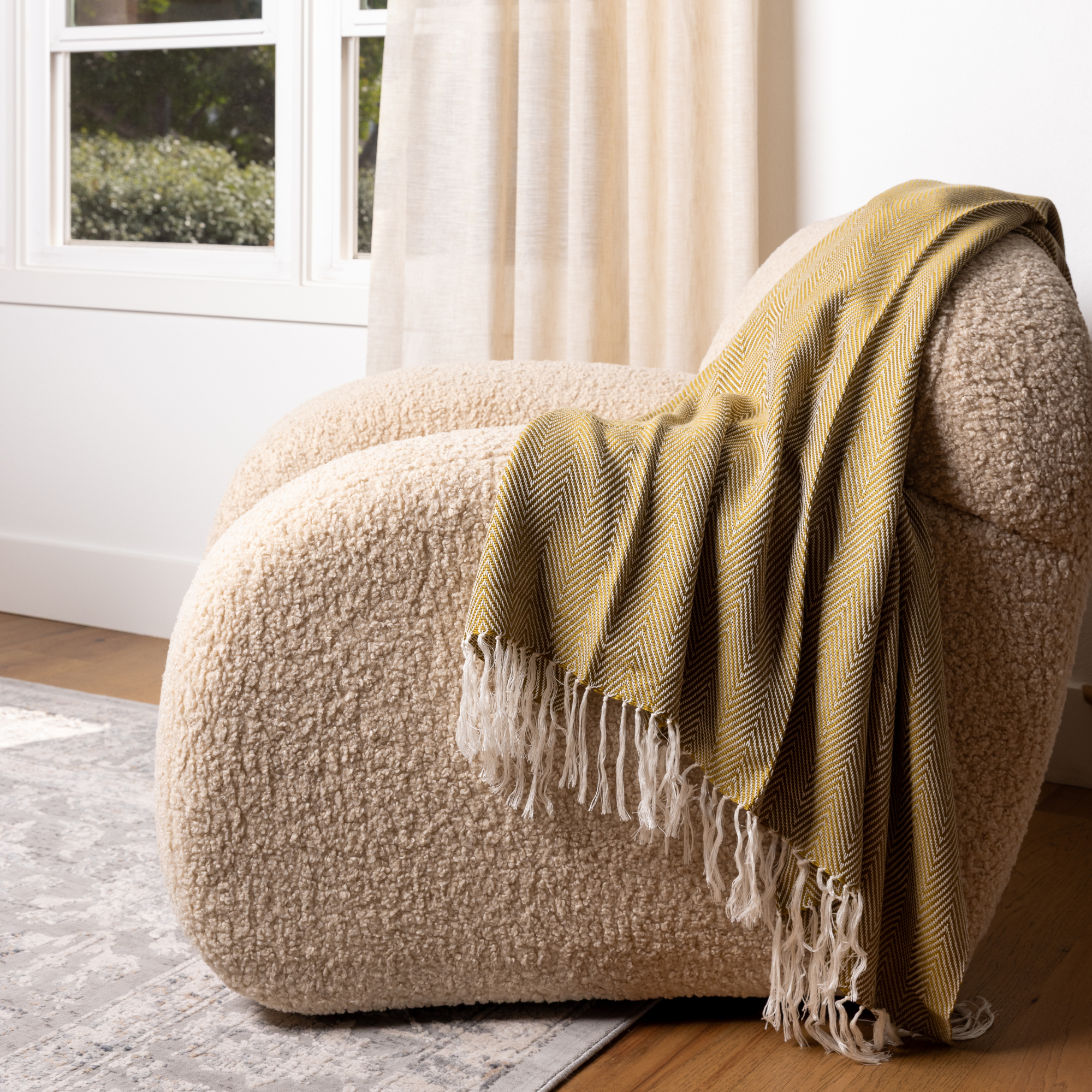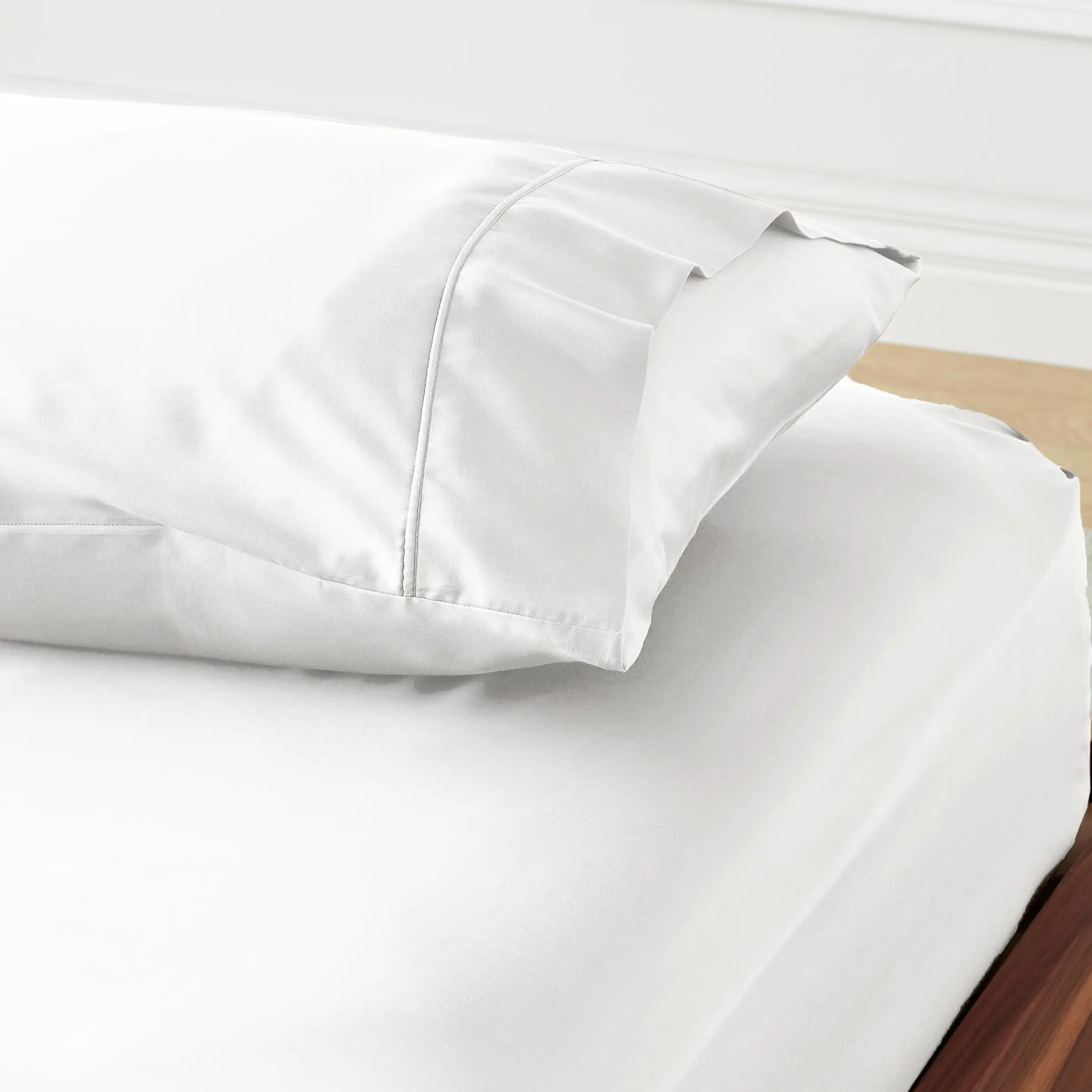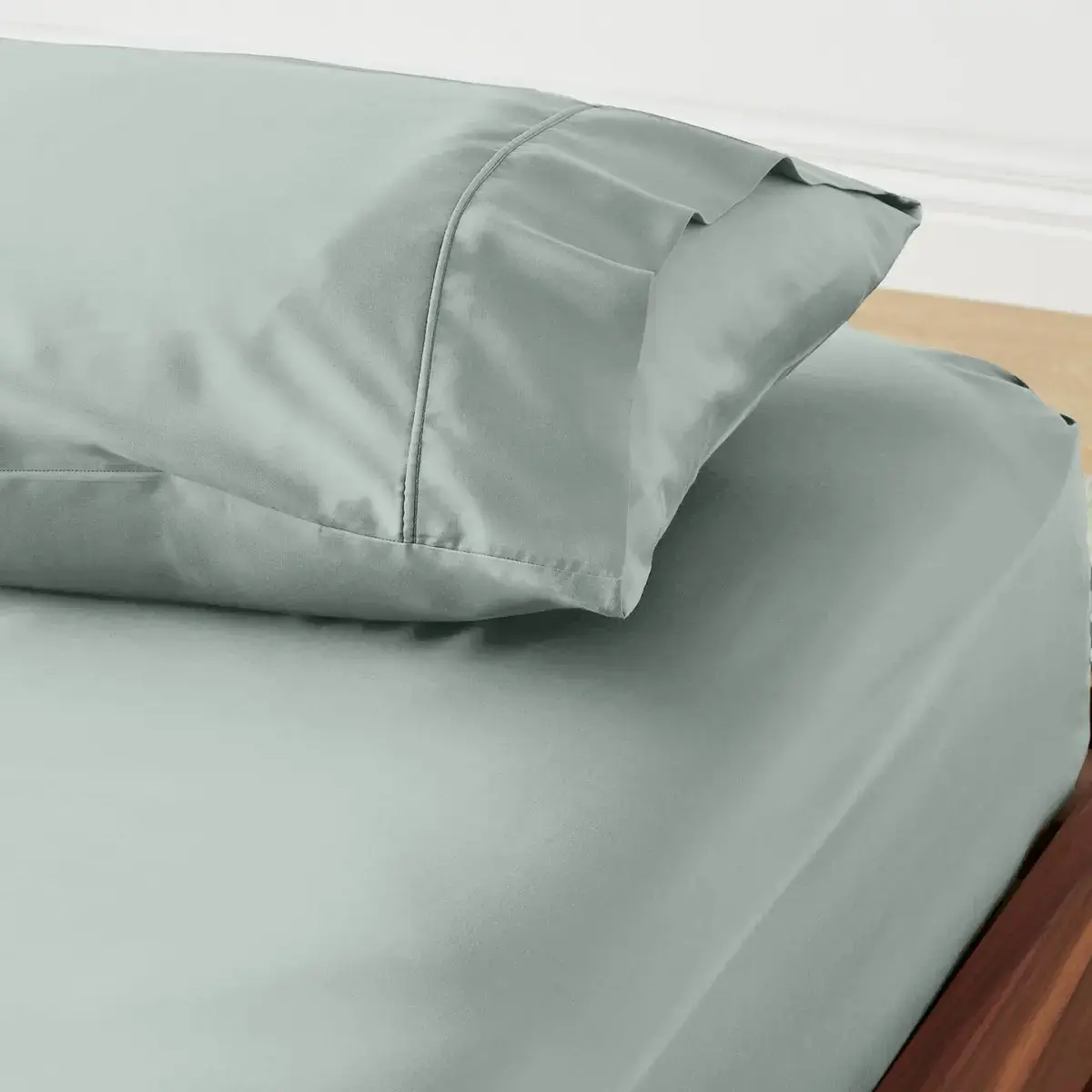We’ve broken down popular bedding materials to determine the best. There are three types of bamboo bedding fabrics: viscose, modal, and lyocell. All three of these fibers are called “cellulosic fibers” since the natural material that makes up the fiber is cellulose, a component of all plants.
Unlike other man-made fibers, viscose, modal, and lyocell are not synthetic. They are made from cellulose, commonly derived from wood pulp, and more recently, bamboo. They are neither synthetic fibers (in the sense of synthetics coming from petroleum) nor natural fibers (in the sense of processing fibers produced directly from plants or animals, such as wool).
However, their properties and characteristics are more similar to those of natural cellulosic fibers (cotton, flax linen, hemp, and jute) than those of thermoplastic, petroleum-based synthetic materials, such as nylon and polyester.
Lyocell bamboo, modal, and viscose are created by breaking raw materials into pulp before being dissolved in a solvent and forming the fabric’s fibers. While all three fabric types come from the same fibers, they’re different. In fact, the method of extracting the cellulose from the bamboo pulp significantly affects the fabric. Let’s take a look at the various types of bamboo materials available on the market today.
Viscose
Viscose is the first generation of these fibers, and the one further enhancements were built upon. It is known by the names viscose rayon and art silk (abbreviated from “artificial silk”) in the textile industry. It has a high luster quality, which gives it a bright shine.
There are many different processes for manufacturing viscose that vary between the chemicals used and their subsequent impact on the environment.
The production of viscose also applies to modal and lyocell: purified cellulose, often from trees, is converted into a soluble compound. A solution of this compound is passed through a spinneret (similar to the holes in a showerhead) to form soft filaments that are then converted or “regenerated” into almost pure cellulose in the final product.
Viscose fabrics can have different strength and stretch characteristics created by adjusting the drawing process applied in spinning. Regular viscose has the largest market share and is typically found in apparel and home furnishings; it is identified on labels as “rayon” or “viscose.” The distinguishing characteristic of regular viscose is its low-wet strength (resulting in loss of stability or a tendency to shrink or stretch easily when wet).
Viscose’s cellulosic base contributes many properties similar to cotton or other natural fibers. Viscose is more moisture absorbent than cotton, soft, comfortable to wear, drapes well, and easily dyed in a wide range of colors. It does not build up static electricity or pill unless the fabric is made from short, low-twist yarns. Viscose does not insulate body heat, making it ideal for use in hot and humid climates.
Viscose has moderate dry strength and abrasion resistance. Like other cellulosic fibers, it is not resilient, which means it will wrinkle. Viscose withstands ironing temperatures slightly less than those of cotton.
Unfortunately, viscose utilizes corrosive materials during production, and many of these chemicals can contaminate water if not disposed of properly. The two toxic chemicals used in viscose bamboo products are sodium hydroxide and carbon disulfide, which contribute to pollution. Therefore, viscose is less environmentally friendly than some people believe. Just because something is made from bamboo, a sustainable material, doesn’t mean the production process is eco-friendly.
Modal
Modal is a second-generation regenerated cellulosic fiber and a variation of rayon. Modal’s distinguishing characteristics are its high-wet strength and extra softness. It is sometimes referred to as being “as soft as a feather” and “the softest fiber in the world.” In addition to its use in general apparel, its softness makes it especially ideal for body contact clothing such as lingerie and undergarments.
Bamboo modal fabric uses a modified production process that is less resource and chemical-intensive than viscose fabric, making it more sustainable. Still, it’s not the most sustainable option for bamboo sheets. However, as the next generation of bamboo products, modal offers the following benefits:
Machine washable
Due to its high-wet strength, modal can be machine-washed and tumble-dried. Modal fibers are dimensionally stable and do not shrink or get pulled out of shape when wet like many rayons. They are also wear-resistant and robust while maintaining a soft, silky feel. Modal fibers are often used in clothing, outerwear, and household furnishings. They are blended with cotton, wool, or synthetic fibers and allow easy tone-in-tone dyeing, which may be done with environmentally friendly dyes, depending on the manufacturer.
Water-absorbent
Modal is about 50% more water-absorbent per unit volume than cotton. It’s designed to dye like cotton and is color-fast when washed in warm water. Even after repeated washing, modal remains absorbent, soft, and supple.
Fade-resistant
The colors in modal typically remain brilliant and intense. Graying, as with 100% cotton textiles, does not occur. Bleaches or whiteners may not be necessary at all. However, if you do use these in any of your launderings, be sure to use environmentally friendly ones.
Soft
The smooth surface characteristics of the modal fiber make it impossible for mineral deposits from water, such as lime scum, to be deposited on the textiles, thus preventing fabric hardening after repeated washes. This “dry rigidity” in some fabrics is caused by the mineral incrustation on the fiber after repeated washing.
Bamboo lyocell
Bamboo lyocell fabric is the most recent generation of bamboo fabrics. But what is bamboo lyocell compared to the other types of fabric? After modal gave us softer and more durable fabrics, lyocell aimed to take on the production process to make it more environmentally friendly. Instead of harsh chemicals, bamboo lyocell uses organic solvents and nanofibrils, making it moisture-wicking, silky-soft, and better for the environment.
The production process for bamboo lyocell fabric is a closed-loop system that makes it greener. Since bamboo is resistant to pests, there’s no need for chemicals like herbicides and pesticides, making it easier to grow with less water usage. Once the bamboo is turned into a pulp, it’s dissolved in the organic compound into a thick solution that’s spun to create fibers, while the organic compound is recovered and recycled. The benefits of bamboo lyocell include the following:
Wicks away moisture
Lyocell has numerous advantages over viscose and modal in its properties and its manufacturing process. One of lyocell's major “claims to fame” is its ability to absorb excess liquid (perspiration) and quickly release it into the atmosphere. It does this while being resistant to developing odors.
The skin is the largest human respiratory organ. Lyocell supports the skin's natural ability, acting as a protective shell to regulate body temperature and maintain water balance.
Nanofibrils are the key to the performance of lyocell. This is the first cellulose fiber to use this nanotechnology. The nanofibrils are hydrophilic (a strong attraction to absorb water), which optimizes moisture absorption with excellent cooling properties that wick away moisture into the air. Lyocell controls and regularly absorbs 50% more moisture than cotton and wool. In contrast, synthetics do not absorb moisture.
Minimizes skin irritation
Rougher fibers can lead to skin irritation. Due to the nanofibrils, the microscopic surfaces of lyocell fibers are smoother than the surfaces of modal, cotton, and wool. The combination of a highly smooth texture and excellent moisture absorption makes lyocell textiles feel soft and pleasant to the skin, making this fabric ideal for active wear, clothing, and bedding for sensitive skin.
Prevents bacteria
Lyocell prevents the growth of bacteria (which causes odors) naturally without chemically treating the material; additional chemicals in the fabric may cause allergic reactions and are environmentally unfriendly. Bacterial growth is prevented through the fiber’s moisture management properties. When moisture is produced, it is directly absorbed from the skin and transported to the inside of the fiber. As a result, no water film is produced on the skin where bacteria could grow.
Clothes and antimicrobial bedding remain odor free for multiple wears much longer than cotton. This also means fewer washes and saving on water and energy as well as on the wear and tear that occurs on any fabric from the washing and drying processes.
On the other hand, synthetics have hundreds to thousands of times higher bacteria counts over the same periods as lyocell. Chemical additives are often used in synthetics and many cotton products to reduce the growth of bacteria.
Hypoallergenic
Bamboo lyocell is hypoallergenic, meaning that it is not likely to cause an allergic reaction in sensitive individuals. This is why it is used for clothing and home furnishings by individuals with Multiple Chemical Sensitivities (MCS), allergy sensitivities, psoriasis, and neurodermatitis. It is also anti-static and doesn’t cling.
Is viscose, modal, and lyocell fabric sustainable?
Viscose, modal, and lyocell are produced from renewable cellulosic plants such as beech trees, pine trees, and bamboo. All three fibers are biodegradable. However, the most sustainable fabric is bamboo lyocell which uses less water and energy within a closed-loop system that recycles water in the process.
ettitude’s bamboo lyocell CleanBamboo® is produced from FSC-certified bamboo. Bamboo grows quickly and without artificial irrigation, pesticides, fertilizers, or gene manipulation that may be used in “wood farms” for industrial use. Our products are also OEKO-TEX® 100 certified to ensure they’re free from harmful chemicals and gentle on sensitive skin.
Lyocell manufacturing is an extremely environmentally friendly process and the most sustainable of these three fibers. The revolutionary aspect of lyocell manufacturing is the recovery and reuse of up to 99.8% of the solvent. Plus, the remaining emissions are broken down in biological water treatment plants. In fact, the solvent is not acidic, and the harmlessness of the solvent has been proven in dermatological and toxicological tests. You can even put your bare hand in it without any skin reaction (although it’s probably not advisable to leave it there). Also, no toxic substances remain in the fiber.
The fiber yield per acre from the bamboo used in the lyocell fibers is up to ten times higher than that of cotton. Also, cotton needs up to 10-20 times more water than lyocell fibers. This means minimal impact on the earth and soil health compared to cotton.
Much of the total environmental impact of textile goods comes from the care of the textiles while in use. With lyocell fabrics, there is no need for fabric softener, whitening agents, or bleach–all of which add cost to the consumer and harsh chemicals to our environment.
Bamboo lyocell (aka CleanBamboo®) is truly an achievement in environmental innovation in fiber production. It is derived from a renewable and sustainably harvested raw material, it is manufactured sustainably, and its disposal is biodegradable to complete the full cycle.
Which fabric is best for you?
When comparing the different types of bamboo fabrics on the market, determining which ones are soft, durable, and eco-friendly can be difficult. Of course, bamboo bedding is made from a sustainable material, but that doesn’t mean all of these products are truly sustainable. Most of the products you’ll find are made from bamboo viscose. While bamboo lyocell and viscose feel similar and are silky-soft, only one is truly eco-friendly. While the manufacturing process for viscose is harmful to the environment, lyocell fabric’s closed-loop system uses non-toxic chemicals and reuses 99% of the resources used during the manufacturing process, ultimately decreasing waste and water consumption.
Bamboo lyocell is the only bamboo fabric that's truly eco-friendly. It’s lightweight, soft to the touch, antimicrobial, moisture-wicking, and temperature-regulating. So, it's no wonder why ettitude’s bamboo bedding and bamboo bath products are made from bamboo lyocell fabric.
If you care about the environment and want to reduce your environmental impact without compromising comfort, shop ettitude’s eco-luxe bedding & bath towels that uplift your home, your outlook and the planet.
Try our sheet sets, duvet covers, and comforters. Our bedding is made from our patented CleanBamboo® lyocell, a breakthrough fabric with all the benefits of bamboo (hypoallergenic, thermo-regulating, moisture-wicking). It offers smoothness and comfort without the guilt associated with bamboo viscose. Browse through our extensive collection and join us in making the world a better place to live in, one step at a time.
FAQs
What’s the difference between bamboo viscose and bamboo lyocell?
Both bamboo lyocell and bamboo viscose are derived from bamboo but differ in texture, quality, and production process. Bamboo viscose is made using caustic soda, a potent chemical that softens the bamboo fibers but eliminates the plant's natural benefits.
As a better alternative to viscose, ettitude developed CleanBamboo® lyocell, which is made using food-grade solvents and a closed-loop production process. This process retains the natural benefits of bamboo - hypoallergenic, breathable, temperature regulating, and moisture wicking - while minimizing the carbon footprint.
Which one is better: bamboo lyocell or bamboo viscose?
Bamboo lyocell is superior to bamboo viscose in quality, health benefits, and environmental impact. Its production uses non-toxic solvents, giving it a uniquely luxurious texture, feel, and superior performance. These solvents also retain bamboo's hypoallergenic properties, resulting in sheets that are gentle on your skin. Additionally, CleanBamboo® has been scientifically proven to improve sleep by over 10%.(Dr. Dan Gartenberg, CEO of SleepSpace.com). Finally, bamboo lyocell is also kinder to the environment than bamboo viscose, with significantly lower water consumption and carbon dioxide emissions.
Does bamboo viscose require a high level of energy to produce?
Yes, the production of bamboo viscose does indeed require a significant amount of energy. This is primarily due to the processes involved in transforming bamboo into usable fiber, necessitating intense heat and electricity. These energy-intensive processes contribute to a substantial carbon footprint associated with bamboo viscose production. This high energy consumption and resulting carbon footprint are important environmental considerations to take into account when evaluating the sustainability of bamboo viscose as a textile material.
Does bamboo lyocell use less water to produce compared to bamboo viscose?
Absolutely! Bamboo lyocell requires less water to produce than bamboo viscose. It is produced using a closed-loop method that reuses water, requiring less water than bamboo viscose. Additionally, it's more environmentally friendly as it avoids the toxic by-products associated with bamboo viscose production.






























































































